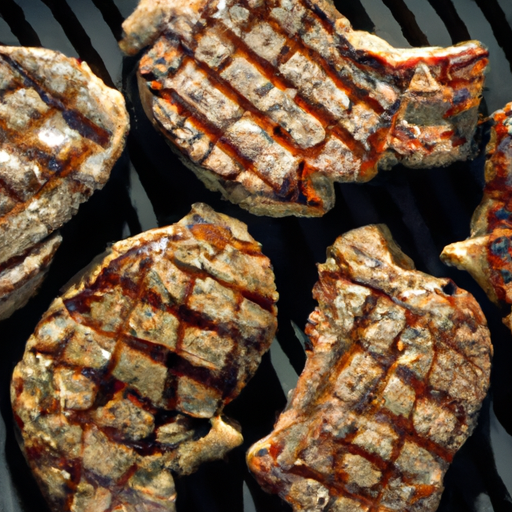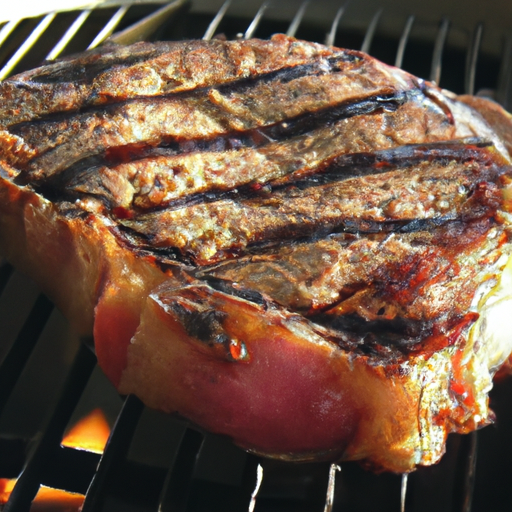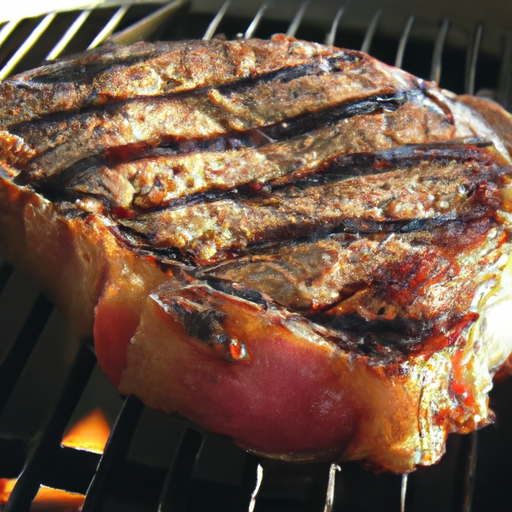If you’ve ever struggled with cooking the perfect steak on the grill, we have the solution for you. Our new product, “Grilling Steak to Perfection,” is the ultimate guide to achieving restaurant-quality steak right in your own backyard. With an easy-to-follow steak cooking chart specifically designed for grilling, you’ll never have to worry about overcooking or undercooking your steak again. Say goodbye to guesswork and hello to mouthwatering, perfectly cooked steaks every time.

Choosing the Right Cut of Steak
When it comes to grilling steak, one of the most important factors to consider is the cut of meat. Not all steaks are created equal, and each cut has its own unique characteristics that can impact the flavor and tenderness of the final dish. So before you fire up that grill, take the time to familiarize yourself with the different types of steak cuts available.
Consider the Different Types of Steak Cuts
There are several different types of steak cuts to choose from, each offering a distinct flavor and texture. Some of the most popular cuts include ribeye, strip loin (also known as New York strip), tenderloin (commonly referred to as filet mignon), T-bone, and porterhouse. These cuts come from different parts of the cow and offer varying levels of marbling, which contributes to their tenderness and flavor.
Know the Qualities of Different Cuts
To make an informed decision about which steak cut to choose, it’s important to understand the qualities of each cut. Ribeye, for example, is known for its rich flavor and generous marbling, making it incredibly juicy and tender when cooked. On the other hand, tenderloin is prized for its melt-in-your-mouth texture and mild flavor. Strip loin offers a balance between tenderness and flavor, while T-bone and porterhouse cuts give you the best of both worlds with a strip loin and tenderloin divided by a T-shaped bone.
Selecting the Best Cut for Grilling
When it comes to grilling, some cuts of steak are better suited than others. Generally, cuts with higher fat content and more marbling, such as ribeye and strip loin, are ideal for grilling as the fat renders during cooking and enhances the flavor. However, this doesn’t mean leaner cuts like tenderloin are off the table. With proper grilling techniques, even lean cuts can turn out tender and delicious. Consider your personal preferences and the level of richness you desire when choosing the best cut of steak for grilling.
Preparing the Steak
Before you begin grilling your steak, it’s crucial to prepare it properly to ensure the best possible outcome. Just like choosing the right cut, proper preparation can make a significant difference in the taste and texture of the final dish.
Start with a High-Quality Steak
The foundation of any great steak is a high-quality piece of meat. Look for steaks that are well-marbled, with even distribution of fat throughout the meat. This marbling not only enhances the flavor but also contributes to the tenderness. Select steaks from trusted sources, preferably ones that have been aged for optimal flavor development.
Seasoning the Steak
Seasoning is essential to bring out the natural flavors of the steak. For a simple yet flavorful option, sprinkle your steak generously with kosher salt and freshly ground black pepper on both sides. Feel free to experiment with additional seasonings such as garlic powder, onion powder, or even a steak rub of your choice. Just remember to season the steak at least 30 minutes before grilling to allow the flavors to penetrate the meat.
Allowing the Steak to Reach Room Temperature
Before grilling, it’s crucial to let the steak come to room temperature. Allowing the steak to rest at room temperature for about 30 minutes before cooking ensures even cooking throughout the meat. This step helps to prevent the steak from becoming overcooked on the outside while staying undercooked in the center.
Preheating the Grill
Properly preheating your grill is key to achieving the perfect sear while locking in the juices and flavors of the steak. Whether you’re using a gas or charcoal grill, these steps will ensure your grill is ready to go.
Cleaning the Grill Grates
Before preheating your grill, it’s essential to clean the grill grates thoroughly. Use a grill brush or a ball of aluminum foil to remove any leftover food particles or debris from previous grilling sessions. Clean grates help prevent sticking and ensure even heat distribution.
Setting Up a Two-Zone Fire
For optimal grilling, it’s best to set up a two-zone fire. This means dividing your grill into two heat zones: one side with direct high heat and the other side with indirect low heat. The direct high heat zone is where you’ll sear the steak, while the indirect low heat zone is for finishing and keeping the steak warm without overcooking it. This setup allows you to control the cooking process more effectively and prevents flare-ups.
Preheating the Grill
Now that your grill is clean and set up for a two-zone fire, it’s time to preheat it. Close the lid and turn on the burners to high heat or arrange the charcoal briquettes evenly across the charcoal grate. Let the grill preheat for about 10-15 minutes to ensure that it reaches the optimal grilling temperature.
Grilling Techniques
Grilling steak is both an art and a science. To achieve the perfect steak, you’ll need to employ various grilling techniques to ensure even cooking, ideal temperatures, and maximum flavor.
Direct vs. Indirect Heat
Understanding the difference between direct and indirect heat is key to controlling the cooking process. Direct heat is when the steak is placed directly above the heat source, which is perfect for searing the exterior and creating those coveted grill marks. Indirect heat is when the steak is placed away from the heat source, allowing it to cook more slowly without the risk of burning.
Determining the Ideal Temperature
To achieve the desired doneness, it’s crucial to cook the steak at the right temperature. Although personal preferences may vary, the following temperature ranges are generally recommended for different levels of doneness:
- Rare: 125°F (52°C)
- Medium Rare: 135°F (57°C)
- Medium: 145°F (63°C)
- Medium-Well: 150°F (66°C)
- Well Done: 160°F (71°C)
Remember that these are internal temperatures, and the steak will continue to cook slightly while resting.
Using a Meat Thermometer
To ensure accuracy and precision when determining the steak’s internal temperature, it’s highly recommended to use a meat thermometer. Insert the probe into the thickest part of the steak, avoiding the bone if present. This guarantees that you have an accurate reading and can pull the steak off the grill at the perfect doneness level.

Grilling Time and Temperatures for Different Doneness Levels
Achieving the perfect doneness for your steak requires careful monitoring of both time and temperature. Here are some general guidelines to help you determine the ideal grilling time for different doneness levels:
Rare
For a rare steak, aim for an internal temperature of 125°F (52°C). This is achieved by grilling the steak for approximately 2-4 minutes per side, depending on the thickness of the steak. Remember to flip the steak only once for even cooking.
Medium Rare
To achieve a beautiful medium-rare steak with an internal temperature of 135°F (57°C), grill the steak for about 5-6 minutes per side. Adjust the timing based on the thickness of the steak and the heat of your grill.
Medium
If you prefer a medium steak with a slightly pink center and an internal temperature of 145°F (63°C), grill the steak for around 6-7 minutes per side. Keep in mind that thicker cuts will require additional grilling time.
Medium-Well
For a medium-well steak with a slightly pink interior but cooked throughout, aim for an internal temperature of 150°F (66°C). Grill the steak for approximately 7-8 minutes per side, adjusting as necessary for the thickness of the steak.
Well Done
If you prefer a well-done steak with no trace of pink and an internal temperature of 160°F (71°C), grill the steak for about 8-10 minutes per side. Again, adjust the timing based on the thickness of the steak and your personal preference.
Grilling the Perfect Steak
With all the preparations, knowledge, and techniques in place, it’s time to grill the perfect steak. Follow these steps to achieve steak grilling perfection:
Placing the Steak on the Grill
Carefully place the seasoned steak on the hot grill grates directly over the direct high heat zone. Close the lid and let it cook undisturbed for the desired time based on your preferred doneness level.
Maintaining the Ideal Grilling Temperature
Throughout the grilling process, it’s essential to maintain the ideal grilling temperature. Adjust the heat as needed, and watch for flare-ups that can cause the steak to char. Use tongs to move the steak to the indirect low heat zone if necessary, especially if you’re cooking a thicker steak that requires more time to reach your desired temperature.
Flipping the Steak
Once the steak has cooked for roughly half the recommended grilling time, it’s time to flip it. Use a pair of tongs to carefully turn the steak over, being mindful not to pierce the meat. Closing the lid after flipping helps to retain the heat and speed up the cooking process.
Basting the Steak
As the steak grills, you may choose to enhance the flavors by basting it with a marinade or a basting sauce of your choice. Basting should be done during the last few minutes of grilling to prevent burning and ensure the flavors meld beautifully with the steak.
Resting and Serving the Steak
One crucial yet often overlooked step in grilling steak is allowing it to rest before serving. Resting the steak ensures the juices redistribute within the meat, resulting in a more flavorful and tender final product.
Allowing the Steak to Rest
Once you’ve achieved your desired doneness, remove the steak from the grill and let it rest. Tent the steak loosely with foil or place it on a warm plate, and let it rest for about 5-10 minutes. This rest time allows the steak’s internal temperature to stabilize, resulting in a more evenly cooked and juicy steak.
Slicing and Serving the Steak
When you’re ready to serve, it’s time to slice the steak. Cut against the grain into thin slices to maximize tenderness. Serve the steak immediately, and savor the delicious flavors and textures you’ve achieved through your grilling mastery.
Tips for Achieving Steak Perfection
To take your steak grilling skills to the next level, consider these additional tips:
Marinating the Steak
Marinating your steak before grilling can enhance the flavors and add moisture to lean cuts. Experiment with different marinades, whether it’s a classic blend of soy sauce, garlic, and herbs or something more adventurous like a chimichurri or bourbon-based marinade. Remember to allow sufficient marinating time, usually at least one hour for the flavors to penetrate the meat.
Using Seasonings and Rubs
Don’t be afraid to get creative with your seasonings and rubs. Beyond salt and pepper, consider adding your favorite herbs, spices, or even a touch of brown sugar for a caramelized crust. Just be mindful not to overpower the natural flavors of the steak.
Experimenting with Different Cooking Techniques
Grilling steak doesn’t have to be limited to one method. Don’t be afraid to try different cooking techniques such as searing on a cast-iron skillet or using a smoker to infuse a unique smoky flavor. Expand your grilling repertoire and explore new ways to elevate your steak game.
Common Mistakes to Avoid
To ensure a flawless grilling experience, steer clear of these common mistakes:
Overcooking the Steak
Overcooking can be the downfall of many a great steak. Remember that the steak will continue to cook slightly as it rests, so aim for an internal temperature slightly lower than your desired doneness level. Use a meat thermometer to ensure accuracy and prevent overcooking.
Underseasoning the Steak
Steak is a blank canvas waiting to be flavored with the right seasonings. Don’t shy away from using ample amounts of salt and pepper, as well as additional seasonings to enhance the taste. Remember that seasoning should be done at least 30 minutes before grilling to allow the flavors to permeate the meat.
Adding Sauce Too Early
If you prefer to serve your steak with a sauce, it’s best to apply it at the end of the grilling process or as a condiment on the side. Applying sauce too early can lead to flare-ups or burnt flavors. Instead, let the natural flavors of the steak shine through and complement them with a delicious sauce or glaze just before serving.
Alternative Grilling Methods
While traditional grilling techniques are tried and true, it’s worth exploring alternative methods that can produce equally delicious results.
Reverse Searing
Reverse searing is a technique that involves slowly cooking the steak at a low temperature and then searing it on high heat to achieve a perfect crust. This method allows for more even cooking and results in a tender and juicy steak. Simply cook the steak in a 275°F (135°C) oven until it reaches an internal temperature of around 10°F (5°C) below your desired doneness, then sear it on the hot grill to finish.
Sous Vide with Grilling
Sous vide is a cooking technique that involves vacuum-sealing the steak and cooking it in a water bath at a controlled low temperature. This ensures precise cooking and perfect doneness. After the sous vide cooking, finish the steak on the grill for a flavor-packed sear.
Smoking the Steak
For those looking to infuse their steak with a rich, smoky flavor, smoking is an excellent option. Use a smoker to slowly cook the steak at low temperatures, allowing it to absorb the flavors of the wood smoke. Finish with a quick sear on the grill to achieve a smoky, caramelized crust.
With these alternative grilling methods, you can add variety and excitement to your steak grilling adventures.
In conclusion, grilling the perfect steak requires a combination of choosing the right cut, proper preparation, preheating the grill, applying grilling techniques, and knowing the ideal grilling time and temperatures. By considering the different types of steak cuts, knowing their qualities, and selecting the best cut for grilling, you set the foundation for a delicious result. Preparing the steak with the right seasoning and allowing it to reach room temperature ensures even cooking. Preheating the grill, cleaning the grill grates, and setting up a two-zone fire create the perfect grilling environment. Using techniques like direct and indirect heat, determining the ideal temperature, and utilizing a meat thermometer help you achieve your preferred doneness level. Following the recommended grilling times and mastering the art of flipping and basting the steak ensure an evenly cooked and flavorful dish. Allowing the steak to rest, slicing it against the grain, and serving it promptly contribute to a satisfying dining experience. Tips such as marinating the steak, using seasonings and rubs, and experimenting with different cooking techniques can take your steak game to new heights. Avoiding common mistakes like overcooking or underseasoning the steak and adding sauce too early helps you avoid disappointment. And finally, exploring alternative grilling methods like reverse searing, sous vide with grilling, and smoking allows for creativity and expanding your culinary repertoire. With these comprehensive steps, you’ll be well on your way to grilling the perfect steak every time. Happy grilling!
